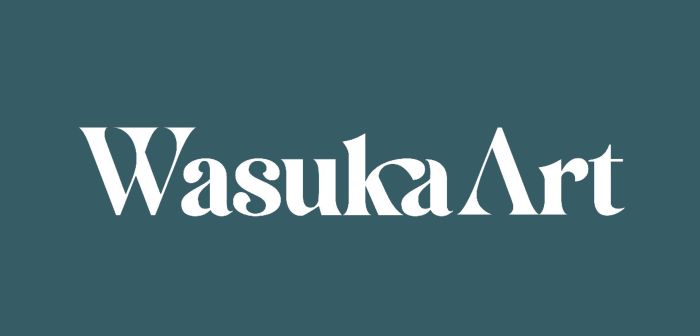
Creating the Wasukaverse
Project Gallery
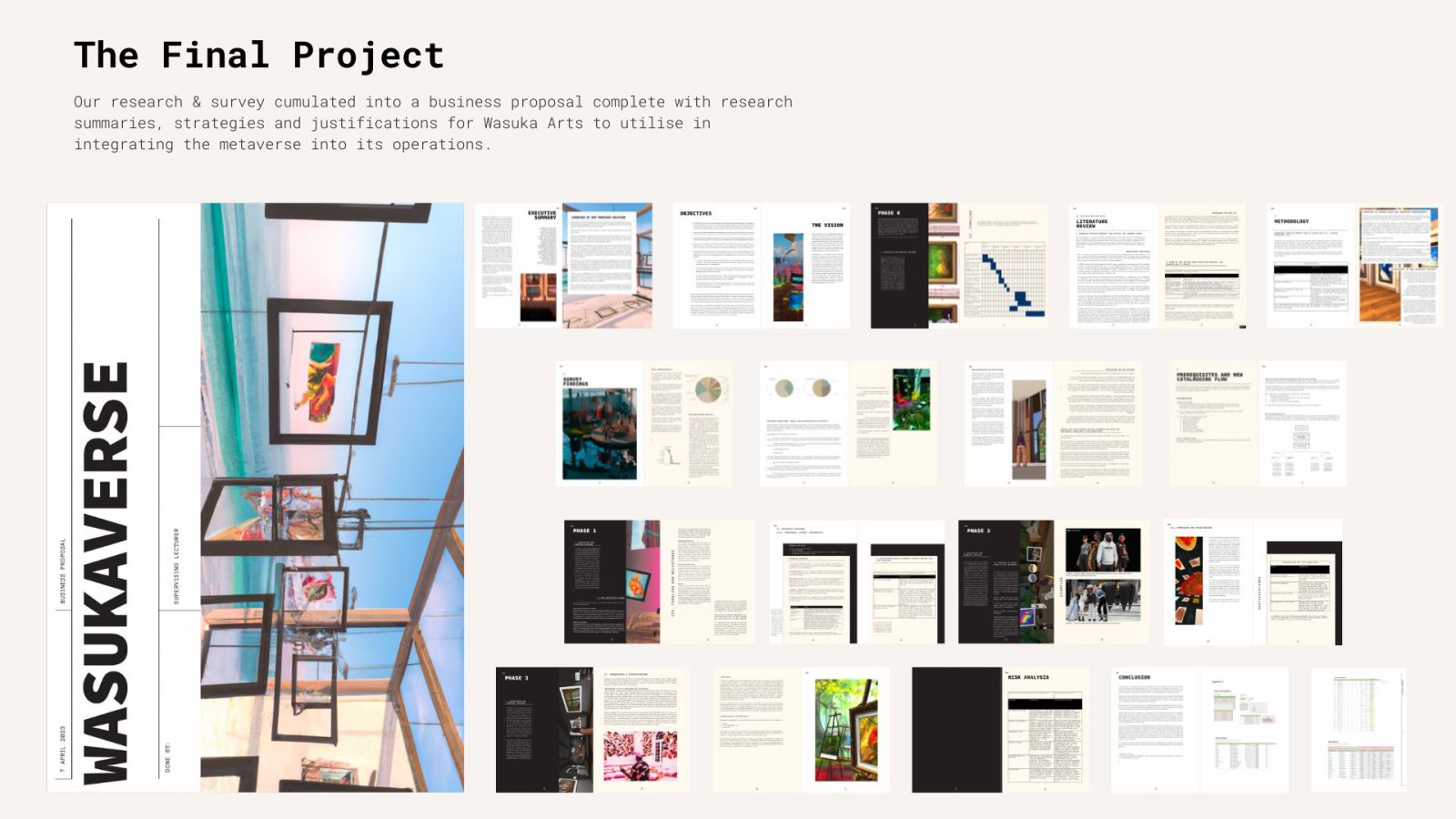
The 'Wasukaverse' Business Proposal
An overview of all the pages in the business proposal design
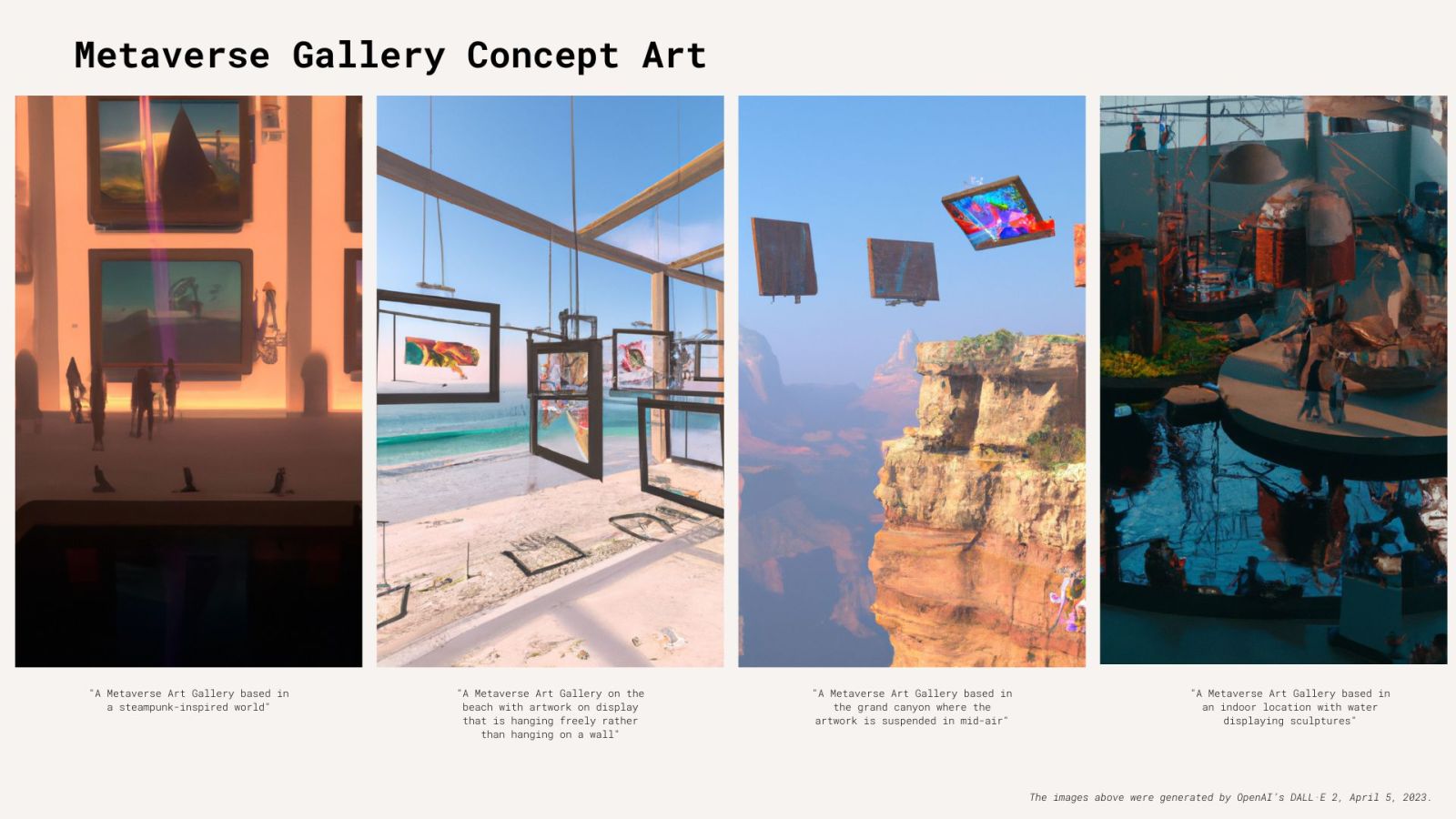
Possible Concept Art Ideas for the Metaverse
Four AI generated images showing concept art to illustrate the potential use of the metaverse as a gallery space
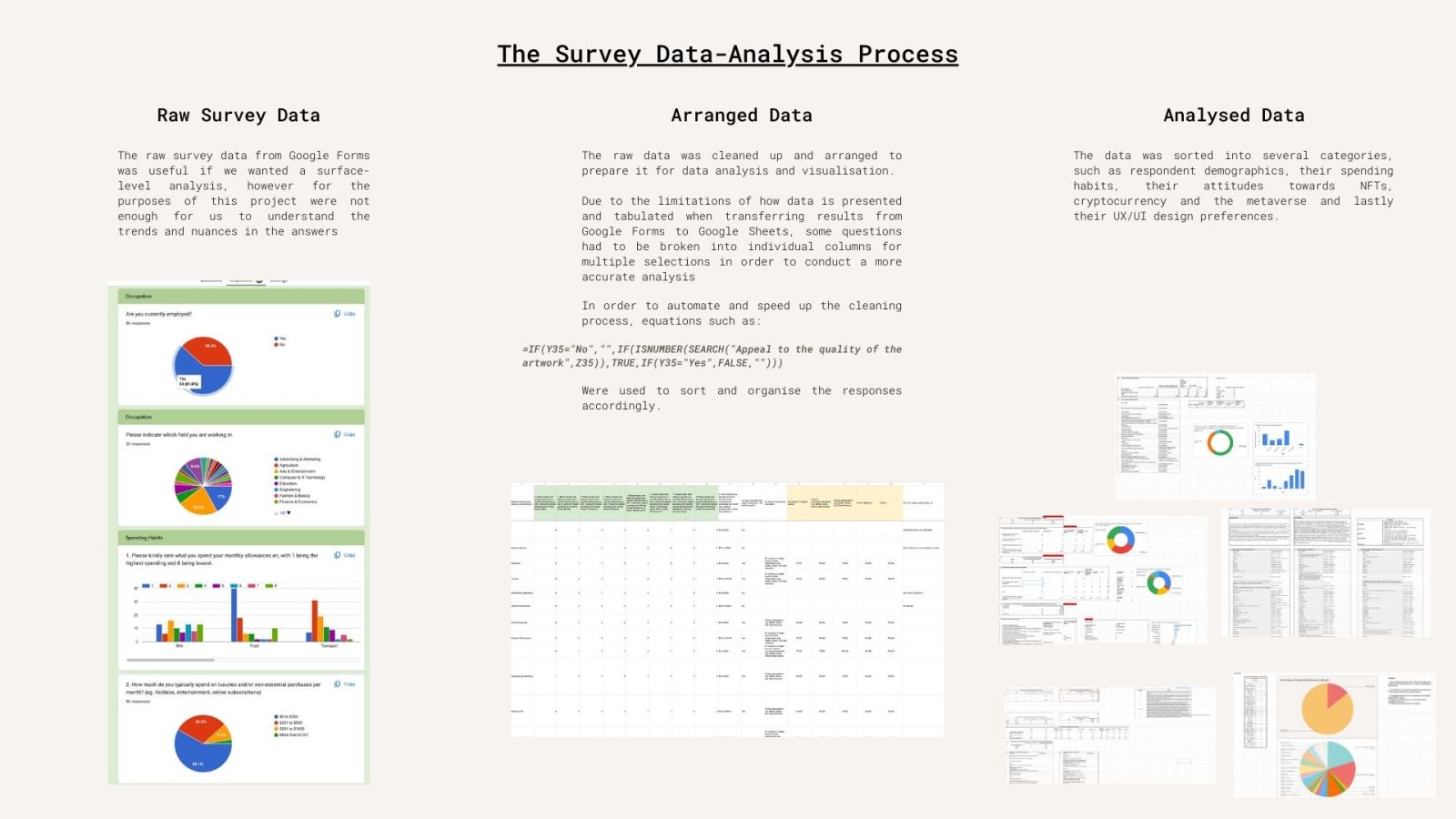
Survey Data Analysis Breakdown
An infographic breaking down the work done to analyse the survey data
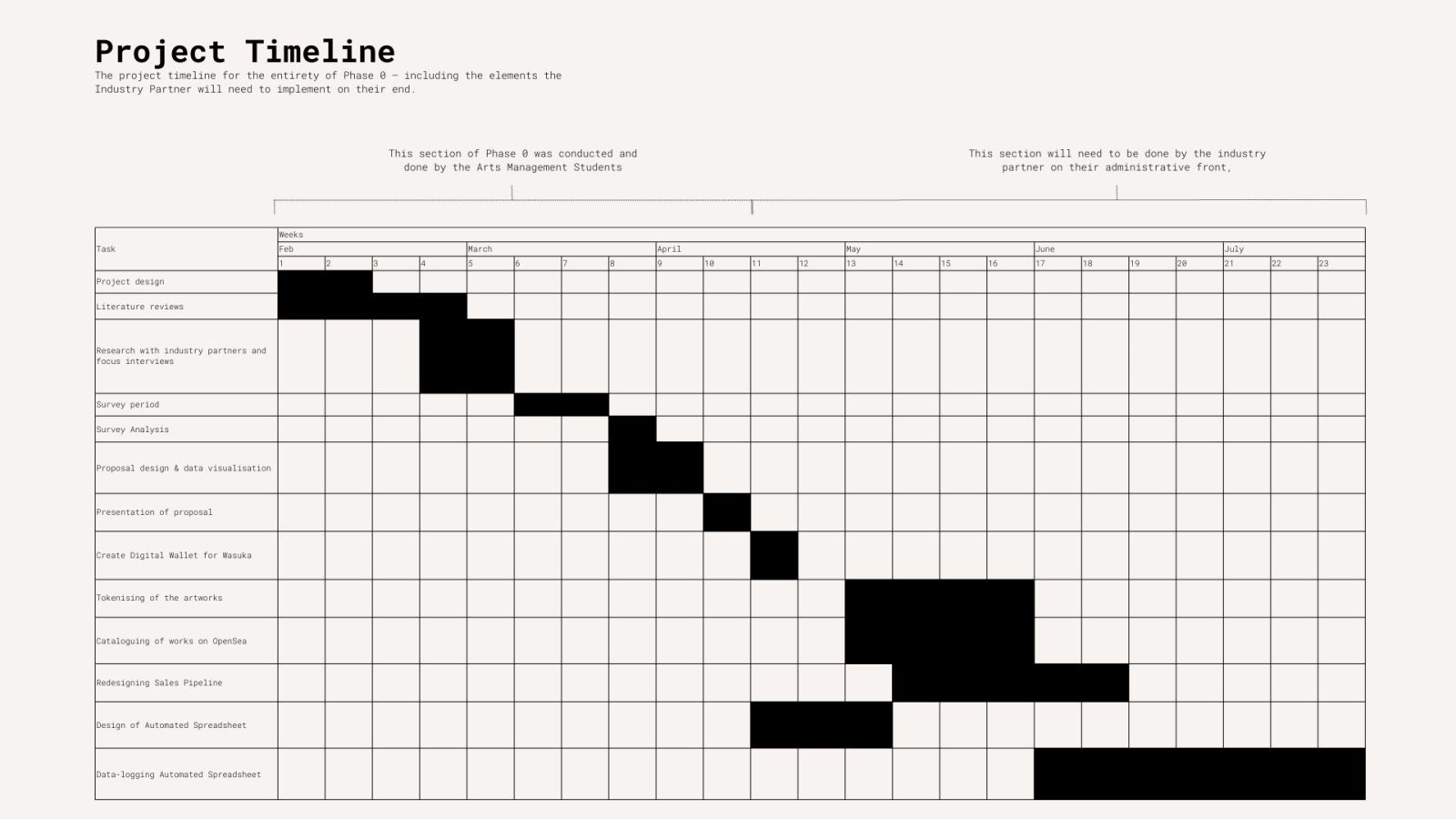
The Phase 0 project timeline
The Phase 0 project timeline
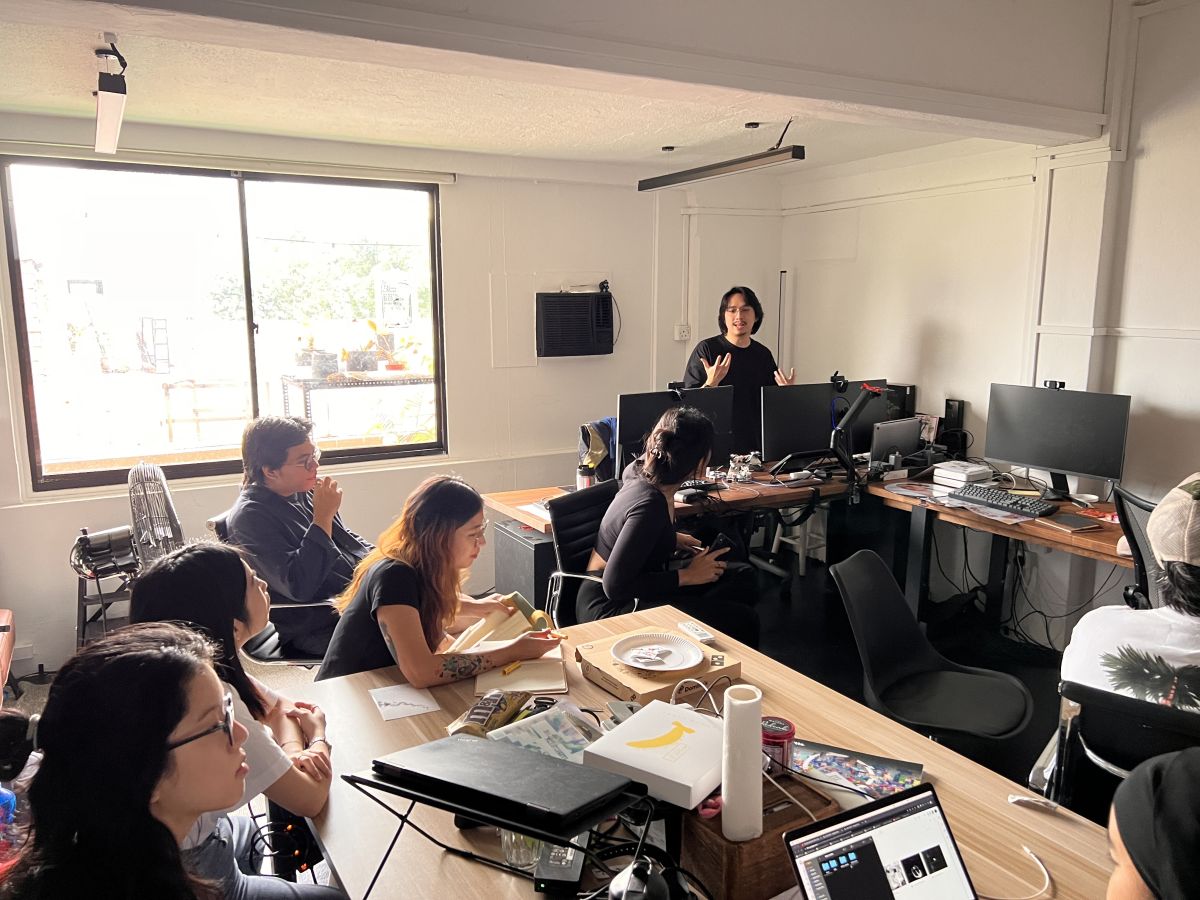
Meeting with SERIAL.co
Students participating in a meeting and presentation with SERIAL.co, a studio based in Singapore that specialises in designing and building metaverse spaces.
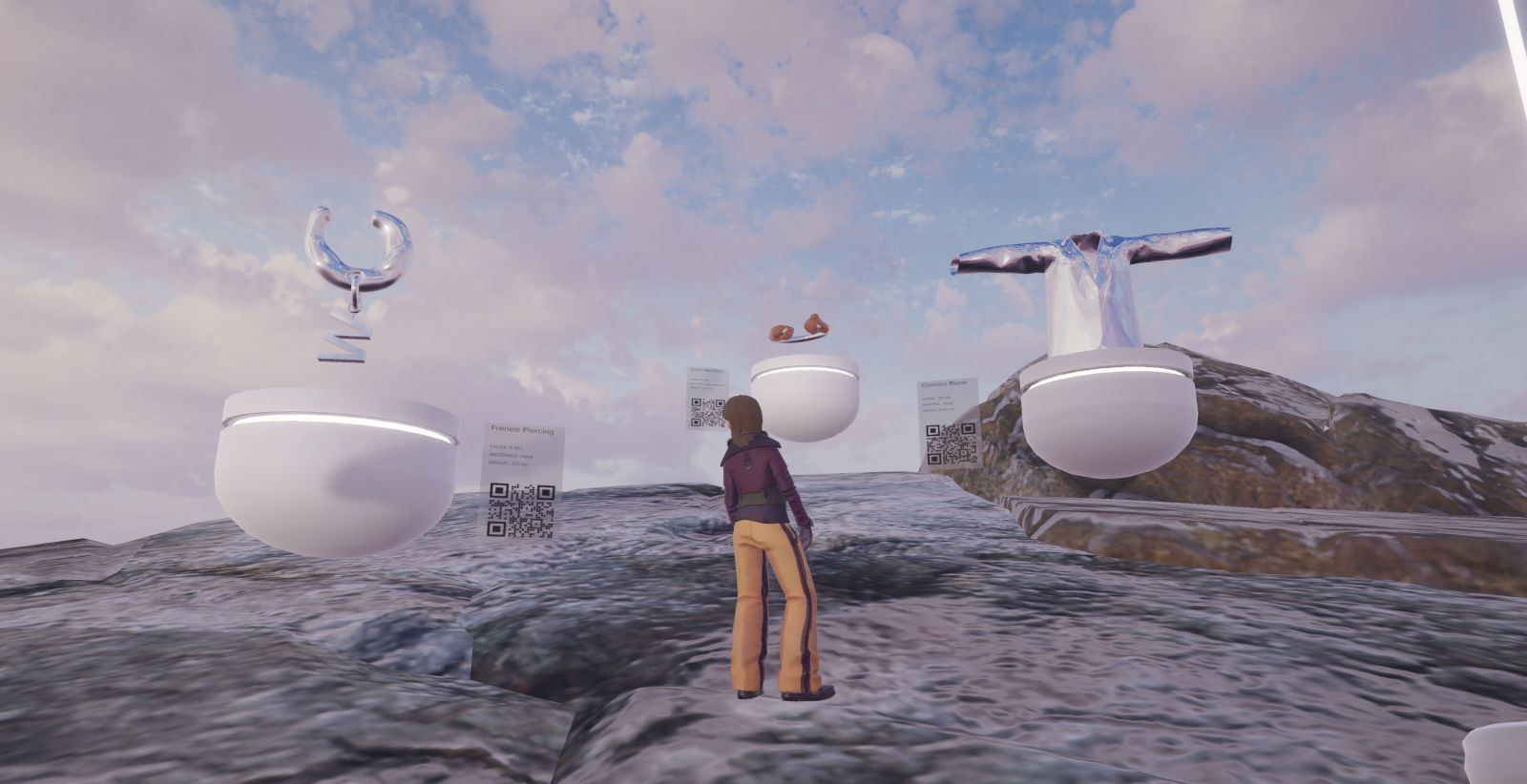
Team member in a metaverse exhibition, complete with artwork info and QR codes
The team exploring metaverse spaces in Spatial.io
Context and problems
Wasuka Art (‘Wasuka’) a visual artist management agency that advises and manages artists, helping them to develop their practice, careers and livelihood. Together with our network of galleries and creative collaborators, we expand our artist's exposure in the global art market and their portfolio of works beyond their usual practices. Since 2022, Wasuka has utilised Instagram as its main communication channel with artists, country managers (China, Japan, Hong Kong), partner galleries, creative partners and even art buyers (newbies and collectors). The website provides only information with no e-commerce functions.
Wasuka’s team, comprising country managers, operates nomadically using Google’s G Suite (Google Drive, Google Meet, Google Calendar) to coordinate respective projects and office matters. Sales transactions and accounting are seamless using HitPay, an online payment gateway. Wasuka intends to build a virtual space to consolidate its operations and, in the future, to be a part of the metaverse by re-engineering its business processes as the company grows. Using blockchain technology, Wasuka can enhance its modus operandi securely and efficiently, as well as to build new revenue channels.
Before Wasuka invests time and money in re-engineering its processes, adopting new technology and building a virtual space, we must understand who we serve, how we serve them and when we serve them.
Some of the key questions include: (1) Who are our tomorrow’s customers? (2) What is their expected behaviour in 5-10 years? (3) What is the technology trend in 5-10 years?
Original Project Deliverables:
Wasuka wishes to engage students from LASALLE College of the Arts to research and provide their recommendations in the following areas:
(1) Customer behaviour, particularly in consuming art from Gen Z.
(2) UI/UX case studies, what appeals to Gen Z?
(3) New technology-enhanced service offerings and how they might influence and facilitate art consumption from Gen Z.
Team Members and Roles
Carla Castle
- Team leader, responsible for overall quality control
- Lead data analyst
- Responsible for cleaning up the raw survey data and visualising them
- Automated data-cleaning
- Spreadsheet designer
- Gen Z and UX/UI research for Phase 1
- Literature review surrounding Gen Zs and UX/UI preferences to understand success factors for different online platforms when engaging Gen Zs
Chermaine Tan Ting Ting
- Business and budget research
- Conducted research on different business platforms and services, including costs and presented data in the form of recommendations based on business needs
- Survey Designer
- Crafted survey questions that sought to understand Gen Z attitudes towards the metaverse, cryptocurrency and NFTs
- Liaison for survey vouchers
- Sourced and assisted in the sending out of survey vouchers to our respondents
Chia Wei Ling
- Literature Review research
- Compiled articles and academic papers on the metaverse, digital exhibitions and similar case studies
- Team Secretary
- Responsible for note-taking and summarising meeting points
- Compiled project documentation
- Business proposal designer
- Phase 0 research
- Researched different administrative tools for the Industry Partner and weighed out different options and recommendations based on the partner's needs and business goals
Nurshafiqa Binte Mohd Noor
- Business and case study research into different B2B monetisation methods when collaborating with creative companies for Phases 2 and 3
- Conducted case studies to understand the success factors of brand collaborations
- Researched different conceptual frameworks used by companies in selling collectables
- Liaison for survey voucher distribution
- Assisted in the instructional sent to survey respondents on how to claim their voucher
- Assisted in emailing respondents the code to their vouchers
Reihan Tan
- Consumer and sales trends research
- Conducted a literature review into emerging consumer trends with regard to the arts and arts-adjacent commodities
- Conducted focus-group interviews to understand artists' potential to create and sell arts-adjacent products to provide a steady revenue stream.
Key Goals and Objectives
Our goals and objectives are:
- Provide a sustainable integration strategy for Wasuka Art’s expansion into the metaverse.
By doing so, Wasuka can smoothly extend its branding and business practices into the metaverse, ensuring that the digital space becomes an integral part of its operations and branding, building a rapport and reputation with the online community. - Ensure the proposed metaverse strategy remains consistent with the gallery's original mission and vision, enhancing its core values and unique identity in the digital realm.
- Develop new revenue streams for the gallery and its artists, leveraging the metaverse's potential for innovative collaboration opportunities, merchandise sales, and expanded audience reach.
- Design the metaverse strategy to support the gallery's long-term growth and adaptability, enabling it to thrive in the rapidly evolving digital landscape and cater to the preferences of emerging generations, such as Generation Z.
- Investigate the use and potential of blockchain tools to improve the efficiency of the gallery's business operations, enabling secure transactions, provenance tracking, and enhanced artist and collector experiences.
By achieving the outlined objectives, our proposal aims to develop a resilient business model that can adapt to emerging trends in the art market while fostering innovation and experimentation among artists and sales methods.
Our primary goal is to establish the gallery as a cornerstone of the digital art gallery sphere. By exploring the potential benefits of blockchain technology for enhancing business operations, we aim to streamline and optimise traditional administrative tasks, freeing up resources for the gallery to focus on its expansion into the metaverse. We aim to create a dynamic, engaging, and sustainable digital presence that remains true to the gallery's original mission and vision while embracing the art world's future.
Project Budget
$500 to conduct research surveys, with each surveyee receiving a $5 coupon voucher.
Project Timeline
The project lasted from end-January 2023 to April 2023. A detailed timeline can be found in the gallery images above.
January:
• 27th: Team meeting. Shared individual research on Generation Z and Metaverse. Dissected the brief of Wasuka Arts, created a timeline, segregated specific roles of each team member, and prepared questions for Jonathan & Kenneth.
February:
• 1st: Team meeting. Wei Ling's takeaways upon meeting Kenneth. Formulating further questions to answer his queries.
• 3rd: Meeting with Kenneth. Open an inquiry if we could have an insight on the backend operations of his business. Further discussion on new systems being digital spaces.
• 10th: Meeting with Jonathan and Jake from Serial Co. Kenneth joined the team. Serial.co introduction to the team. An in-depth understanding of the capabilities and limitations of Spatial.
• 17th: Meeting with Kenneth. Clarity on what Kenneth wants. Preference of values for Artworks.
March:
• 3rd - 17th: Research with industry partners and focus interviews.
• 3rd - 17th: Survey period and survey analysis.
• 10th: Team meeting with Jonathan. Further worked on the research. Checking up on survey participants, ensuring the number of participants was filled.
• 14th: Team meeting. Shared more information on digital space collaborations with brands. Research on cost and ensure it suits Kenneth's budget.
• 17th: Team meeting. Discussions of Phase 3 implementations.
April:
• 1st - 9th: Proposal design & data visualization.
• 10th: Presentation of the proposal.
• 11th - 14th: Create a digital wallet for Wasuka Arts.
• 14th - 1st May: Design of automated spreadsheets.
Project Methodologies
Approaches taken and methods used to gather data
To develop our innovative gallery business model, we took an exploratory approach, examining adjacent industries with established digital presences, such as video games and social media companies, and drawing inspiration from their successes. Then, recognising the gallery's objective to increase revenue streams, we conducted several case studies on collectable items with high consumer demand, demonstrating the viability of a high-volume, low-selling price strategy for collectables.
The methods used ranged from:
- Researching academic articles
- Reading case studies
- Focus group interviews
- Autoethnographic research, documenting our personal experiences in the metaverse
- A survey we conducted to gether key insights on Gen Z preferences and attitudes
Our survey was meant to ensure our proposed strategies resonate with the Gen Z demographic. The survey collected information on:
Survey Objectives
- Understanding Generation Z's demographics and spending habits
- Understanding Generation Z's Attitudes towards art
- Getting Generation Z's impressions of the Metaverse, NFTs, and Cryptocurrency
- Understanding Generation Z's UX/UI Preferences
Limitations in the research process
Literature Review: Due to the developing nature of the metaverse, more academic resources need to discuss its success factors and business implications. As a result, our proposal relies on some degree of speculation and extrapolation from existing information.
Case Studies: The unique circumstances surrounding each case study may introduce survivorship bias, as we primarily examine successful examples from adjacent industries. Therefore, the conclusions drawn from these case studies may not universally apply to the art gallery's situation.
Survey: The short timeframe and limited budget for conducting the survey restricted our ability to reach a diverse range of participants from different industries. With 20.4% of respondents coming from the arts, the survey results may be skewed towards this demographic, potentially affecting the generalizability of our findings.
Project Research Insights
The key insights from the literature review that informed our proposal were the following:
1. Place emphasis on interactive marketing
Gen Zs are more likely to respond positively to personalized and immersive experiences.
2. Focus on High-Quality and Exclusive Content
High-quality and unique content appeals to Gen Zs, making it important to offer something unique and authentic that stands out
3. Leverage AR & Mixed Reality
The literature has shown that using a mix of augmented reality (AR) or mixed reality (MR) elements helps enhance the metaverse experience.
While the above key insights were found through literature reviews, a key gap and question the team needed to address was the willingness of Gen Zs to purchase digital commodities and engage in a virtual space.
However, the survey conducted by the team provided more specific findings:
Gen Z Spending Habits:
- Top priorities: food, transport, and clothes
- Most spent $201-$500/month on non-essentials
- 62.35% made digital purchases in the past six months
- Online subscriptions were the most common digital purchase
Attitude towards the arts:
- 68.24% are interested in purchasing art
- Key factors: quality, affordability, investment, wall space
- 52.94% had purchased artwork before
- 87.06% open to purchasing artist merchandise or collectables
Attitudes towards NFTs, crypto, and the metaverse:
- 87% never purchased NFTs
- Mixed views on metaverse; mostly negative towards NFTs and crypto
- Metaverse holds the potential for engaging interested consumers
Gen Z preferences for UX/UI design:
- Social aspects and convenience are crucial
- No dominant navigation method; familiarity with video games important
- Cost and ease of use as primary factors in platform choice
These findings offer insights into Gen Z's spending habits, attitudes towards art, views on NFTs, crypto, metaverse, and preferences for UX/UI design, which can inform Wasuka Arts' strategies for engaging this demographic.
Project Vision and Expected Outcomes
The overarching vision for Wasuka Art emerges from a pivotal question addressing its primary concerns: How can a gallery or artist management company remain relevant and thrive amidst disruptive technologies like blockchain and NFTs? How can Wasuka Art maintain its relevance and establish itself as an invaluable asset within the art ecosystem that empowers artists, benefits stakeholders, and achieves financial self-sustainability?
Consequently, the team envisions Wasuka Art as an innovative cornerstone in the ecosystem, becoming the go-to destination for immersive art experiences (both digital and in-person), a company that guarantees its artists a sustainable living, and one that effectively bridges the needs of diverse stakeholders through collaboration. This proposal outlines a multi-phase approach, promoting experimentation with virtual spaces while ensuring stability and viability before initiating each phase. The ultimate goal is facilitating Wasuka Art's seamless transition towards the emerging Gen Z market, adeptly catering to their unique purchasing interests and bridging generational divides.
Thus, the expected outcome is a business proposal grounded in research. One that the industry partner can use as a frame of reference when pursuing the development of the 'Wasukaverse'
Project Deliverables and Outputs
Our final proposed project deliverable was designed with the industry partner and their ethos in mind — Wasuka does what it does, 'all for the artist'. Therefore, through close discussion and collaboration with the industry partner, we proposed the following deliverables to reach the intended goal in mind:
Propose a model for Wasuka Art that integrates metaverse elements into its business model to:
- Improve and automate its operations where possible
- Value-add its servicing to both the clients and value for its artists
- Speculate on possible ways the company can commodify different products to build a new, sustainable revenue stream.
Conduct market research on Gen Zs to understand their:
- Spending habits
- Interest and understanding of the metaverse and NFTs
- And UX/UI preferences, where the research will inform the proposal and the subsequent recommendations given
SWOT analysis
Wasuka Art Strengths
- An artist management company with pre-existing art programmes that act as a decentralised gallery space
- Pre-existing partnerships and relationships with companies and hotels for its art programmes
- Steady sales revenue and years of experience in the industry
Wasuka Art Weaknesses
- Small team, with a small full-time staff team, complemented by ad-hoc country managers across the region.
- No marketing staff to manage the company's brand and audience engagement efforts.
- Lower awareness among the gen Z demographic
Opportunities
- Wasuka's business model is adaptable to any space, making it a great contender for experimenting with virtual spaces
- Opportunities to collaborate with brands on virtual spaces
- Potential to integrate more multi-media technology to build on customer experience and raising brand awareness
Threats
- If bigger artist management agencies or art galleries decide to invest in a virtual space, Wasuka may get shadowed by the bigger name artists
- Lack of awareness of the metaverse and stigma surrounding NFTs
- Barrier to entry to use of certain NFT services and/or metaverse platforms





